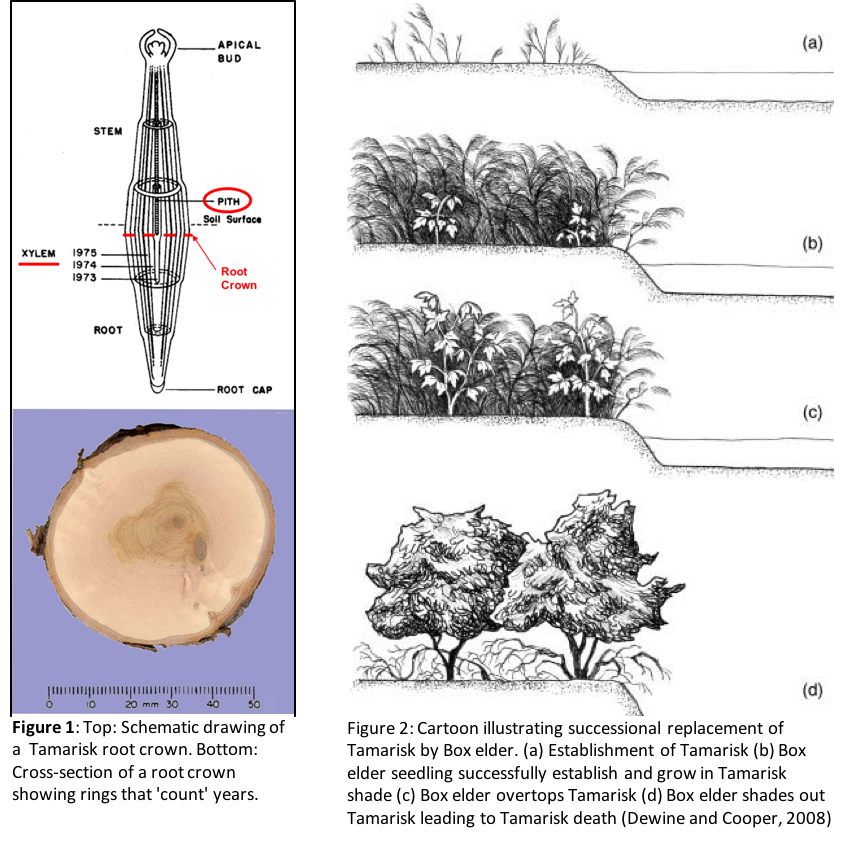Invasive species can drastically alter the ecosystem landscapes and impact native species by affecting resource availability, disturbance regimes, and successional trajectories. Tamarisk (Tamarix sp.) is a non-native invasive species in the Colorado River basin endemic to Eurasia and Africa that competes with native species and impacts river ecology and morphology. Tamarisk is a woody shrub also known as salt cedar. The presence of Tamarisk in the Colorado River basin has had a number of negative impacts. Historic management practices have operated on the assumption that reduced flow from the Glen Canyon dam allowed Tamarisk to invade undisturbed bars and banks, outcompeting native species, increasing water demand, and increasing soil salinity. Annually, millions of dollars are spent trying to reduce presence of Tamarisk in the Colorado River basin. Management techniques are described as being either top-down or bottom-up. Top-down control techniques focus on the physical removal of the invasive species of interest, while bottom-up control techniques limit the resources available to the invasive species by manipulating disturbances (e.g., floods, fires, etc.), competition, and succession. These management techniques differ in tenor, effectiveness, cost, and collateral impact. Top-down control techniques are often costly, disruptive, and labor intensive, adding to total cost. These top-down control techniques include aerial herbicide application (with collateral destruction), foliage and cut stem herbicide application (effective but expensive), mechanical control (disruptive bulldozing: effective, costly), mechanical removal of Tamarisk root crowns (labor intensive), and introduction of insect herbivores (inexpensive and self-sustaining, but efficacy unclear).
A key environmental management question regarding Tamarisk in the Colorado River basin revolves around whether dams create a niche for Tamarisk promoting the invasion and establishment of Tamarisk and would reinstating a natural flow regime eliminate Tamarisk recruitment and allowing for recruitment and reestablishment of native species. To address this, it is useful to understand the establishment history of the Tamarisk in the Colorado River basin and the interactions (i.e., competition vs. facilitation, etc.) that Tamarisk is involved in within the native ecosystem. Tree-ring dating can be applied to Tamarisk root crowns to determine the establishment history of Tamarisk in the Colorado River (Figure 1). Comparison of establishment ages indicate that there was significant establishment of Tamarisk prior to the emplacement of the dam. This suggests that Tamarisk was spreading throughout river basin prior to the dam and continues to spread with it in place.
Moreover, the establishment ages indicate that Tamarisk benefits from flood events by transporting seeds and creating sand bars for establishment of seedlings. The establishment ages indicate that most Tamarisk was recruited and established in years that experienced floods that were then followed by lower flow years. However, native species are adapted to these conditions and may rely on natural flow conditions more directly than Tamarisk. Thus, considering the way in which Tamarisk interacts with the native ecosystem is critical in developing future management practices. Cottonwood (Populus) and Box Elder (Acer negundo) are riparian trees native to the Colorado River Basin, and historically Box Elder was the only woody species in several canyons. Tamarisk and Box Elder are codominant and are often found together in mixed strands. However, Tamarisk may not directly compete with other native species, and, as opposed to outcompeting native species, Tamarisk may fill a non-native niche. The native Box Elder grows well in the shade created by Tamarisk, and can grow to overtop and subsequently shade out the Tamarisk. Tamarisk is not very shade tolerant and is killed after 2-years of shade. Cottonwood saplings can also overtop and outcompete Tamarisk. Thus, the successional replacement (i.e., the way in which a local ecosystem develops over time) potentially favors the establishment and preservation of these native species.
While a natural flow regime will benefit both Tamarisk and native woody plants, Tamarisk is moving upstream into un-dammed rivers. A current study by Kui and Stella (2016), indicates that burial by flood sediment completely kills Tamarisk and Cottonwood seedlings, but Box Elder seedlings can protrude through the sediment.
Moreover, early assumptions regarding Tamarisk water usage and soil salination may not be valid (Stromberg et al., 2009). Tamarisk uses similar amounts of water as native woody species, and removal of Tamarisk will not produce more flow through the river basin. Although Tamarisk is salt-tolerant, there is no evidence to suggest that Tamarisk increases soil salinity, increasing pressures on native species. The application of high flow experiments to produces floods capable of building sand bars and burying Tamarisk seedlings while planting Cottonwood and Box Elder may accelerate natural successional replacement. Encouraging native plant establishment may prove to be a more efficient use of resources than mechanical removal of Tamarisk from the Colorado River Basin.

References:
DeWine, J.M. and Cooper, D.J., 2008. Canopy Shade and the Successional Replacement of Tamarisk by Native Box Elder. Journal of Applied Ecology, 45, 2, 505-514.
DeWine, J.M. and Cooper, D.J., 2010. Habitat Overlap and Facilitation in Tamarisk and Box Elder Stands: Implications for Tamarisk Control Using Native Plants. Restoration Ecology, 18, 349-358.
Kui, L., and Stella, J.C., 2016. Fluvial sediment burial increases mortality of young riparian trees but induces compensatory growth response in survivors. Forest Ecology and Management, 366, 32-40.
Stromberg, J. C., M. K. Chew, P. L. Nagler, and E. P. Glenn. 2009. Changing Perceptions of Change: The Role of Scientists in Tamarix and River Management. Restoration Ecology 17:177–186.
